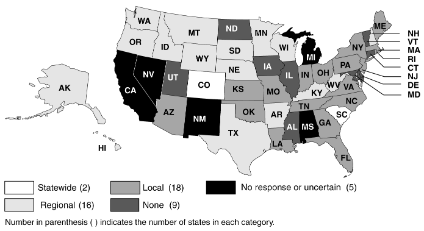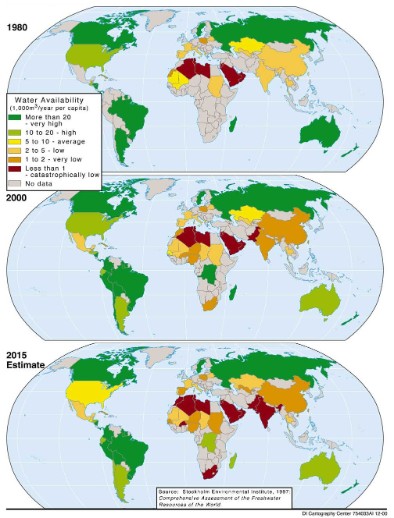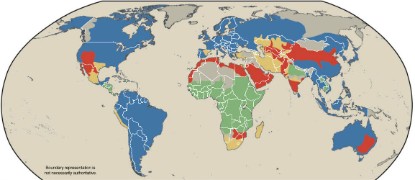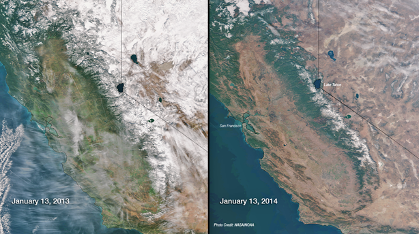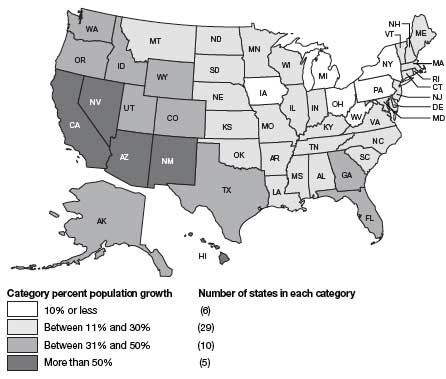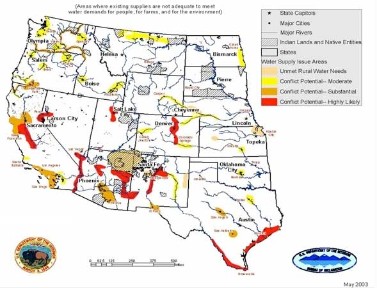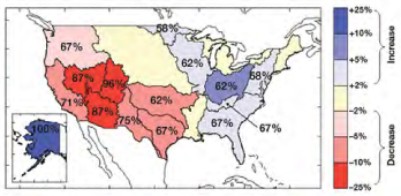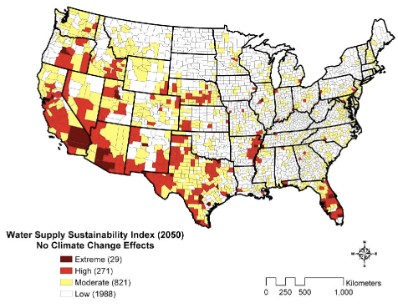Water Supply Shortages | Water Scarcity
2013 - Climate Change and Water Supplies
2013. Water shortages projected for 36 states by 2013. “Water managers in most states expect shortages of freshwater in the next decade [2003 – 2013] — even without drought — and the consequences may be severe, according to a General Accounting Office [GAO] report. . . . The nation's capacity for building new dams and reservoirs to store surface water is limited, and groundwater in many parts of the country is being depleted faster than it can be replenished, the report said.
At the same time, the GAO reported, a growing population and increased pressure to allocate water to fisheries and the environment are placing new demands on the freshwater supply. The potential effects of climate change also create uncertainty about future water availability and use, the report said. Most climate experts expect global warming to create more droughts and more extreme storms.
As a result, water managers in 36 states surveyed by the GAO said they anticipate water shortages in the next 10 years [2003 - 2013] under ‘average water conditions.’ Two states · Colorado and South Carolina · expect shortages to be statewide. . . .
But even without drought conditions, the shortages could have ‘severe consequences,’ the report said. There have been eight water shortages resulting from drought or heat waves over the past 20 years resulting in more than $1 billion in damages each, the report said. The most costly totaled over $40 billion in damages to the economies of the central and eastern United States in the summer of 1988.” Cost of global warming. (Joan Lowy, Scripps Howard News Service, “Most states predict water shortages in next decade,” Scripps Howard News Service, Thursday, July 10, 2003 reporting findings in U.S. General Accounting Office, "Freshwater Supply - States' Views of How Federal Agencies Could Help Them Meet the Challenges of Expected Shortages," GAO-03-514, July 2003)
36 States to Face Water Shortages by 2013
State water shortages likely to occur under average water conditions over the decade 2003 - 2013. Source: GAO, Freshwater Supply - States' Views of How Federal Agencies Could Help Them Meet the Challenges of Expected Shortages, General Accounting Office, Washington, DC GAO-03-514, July 2003, pp. 5, 8, 64, 65
2013. Lake Mead’s water levels could drop below its water intake pipes by 2013. “Southern Nevada Water Authority chief Pat Mulroy . . . said the authority is in a race against time to complete a new [third intake] system [or third straw] to draw water from deep in Lake Mead [Hoover Dam]. Roughly 90 percent of the [Las Vegas] valley's drinking water is drawn from the lake through the two existing intakes, but the reservoir's surface could shrink below the level of one of those pipes by 2013.” (Pat Mulroy, general manager of Southern Nevada Water Authority quoted in Henry Brean, hbrean@reviewjournal.com, 702-383-0350 “Water Authority: Mulroy calls new Lake Mead intake system is critical,” Las Vegas Review-Journal, Las Vegas, Nevada, May 22, 2009) See videos of Pat Mulroy speaking on water issues.
Hoover Dam - Lake Mead Water Levels, 1983 and 2007
Source: Pat Mulroy, General Manager, Southern Nevada Water Authority, Lake Mead Intake No. 3, Keynote address, PowerPoint presentation, Environmental Services Association of Alberta, Banff, Alberta, Canada, April 22, 2010
___________________________________________________
We're in a race against time... (7)
We're teetering on the first shortage right now. How quickly [Lake] Mead goes down [is based on hydrology] probability. But the whole probability analysis, because of climate change, has been thrown out the window. We're experiencing anomaly after anomaly. (8) — Pat Mulroy, General Manager
Southern Nevada Water Authority
___________________________________________________
Are scientists and policy-makers underestimating the potential severity of water shortages?
How have climate change forecasts compared
to real world observations of the forecast periods?
___________________________________________________
2013. Hydroelectric turbines at Hoover Dam could cease generating electricity by 2013.
“After 75 years of steadily cranking out electricity for California,
Arizona and Nevada, the mighty turbines of the Hoover Dam could cease
turning as soon as 2013, if water levels in the lake that feeds the dam
don't start to recover, say water and dam experts. Under pressure from
the region's growing population and years of drought, Lake Mead was
down to 1,087 feet, a 54-year low, as of Wednesday [September 8, 2010]. If the lake loses
10 feet a year, as it has recently, it will soon reach 1,050 feet, the
level below which the turbines can no longer run.
Those hydroelectric
generators produce cheap electricity for the Metropolitan Water
District of Southern California [MWD], which is responsible for pumping
water across the Colorado River Aqueduct to hydrate much of Southern
California. Without that power, Metropolitan's costs to transport
water will double or even triple, a district executive said. . . The
decrease in water already experienced at Lake Mead has reduced output
from the turbines from 130 megawatts of peak capacity to 100, according
to Peter DiDonato, who runs the Hoover Dam's hydroelectric generators.
. .
For every foot of elevation lost in Lake Mead -- about 100,000 acre
feet of water, or enough for 200,000 households -- the dam produces 5.7
megawatts less power. That's because at lower water pressure, air
bubbles flow through with the water, causing the turbines to lose
efficiency. . . . Losing power from the Hoover Dam would raise expenses
for Metropolitan [see MWD map] and for Southern California Edison
[SCE], both of which buy power for the dam at low rates. Edison has
already begun preparations for lower power generation from the dam,
which represents 0.3 percent of its portfolio, said Gil Alexander, a
spokesman for the utility.
The dam supplies 60 percent of
Metropolitan's power needs, said Brian Thomas, chief financial officer
and assistant general manager of the agency. Without power from the
dam, Metropolitan would turn to the spot electricity market and pay
double or triple the cost, depending on how much less power the dam is
producing.” (Eric Wolff, ewolff@nctimes.com, 760-740-5412, “Hoover Dam
could stop generating electricity as soon as 2013, officials fear,”
North County Times, Escondido, California, September 12, 2010)
Declining Water Levels at Lake Mead Require
Construction of Third Intake to Draw from Deeper Water
Southern Nevada Water Authority’s (SNWA) new Lake Mead Intake No. 3 is being built to protect against reductions in electricity generation system capacity caused by declining lake levels as well as water shortages incurred by the City of Las Vegas which depends on the lake for 90% of its water supply. Third straw Lake Mead. Source: Southern Nevada Water Authority and Jean Reid Norman, “Water demand drop-off postpones intake work,” Las Vegas Sun, Sunday, Sept. 13, 2009.
Americans lose 30% of their tap water to leaky and inefficient municipal systems before it even gets piped into homes. (9)
Richard Meeusen
CEO, Badger Meter
2014 - Global Warming and Water Supplies
2014. 10% chance that Lake Mead could be dry by 2014. “[In When will Lake Mead go dry?, a Scripps Institution of Oceanography study, research marine physicist Dr. Tim Barnett and climate scientist David Pierce] estimated that there is a 10 percent chance that Lake Mead could be dry by 2014." (“Lake Mead Could Be Dry by 2021,” news release, Scripps Institution of Oceanography, University of California, San Diego, Tuesday, February 12, 2008 reporting findings in Tim P. Barnett and David W. Pierce, "When will Lake Mead go dry?," Scripps Institution of Oceanography, University of California San Diego, La Jolla, California, Journal of Water Resources Research, January 23, 2008) See Barnett video on “Outlook for Lake Mead” and “How the forecast was created.”
2015 Climate Change and Water Availability
2015. Nearly half the the world’s population will live in water-stressed countries by 2015. “By 2015 nearly half the world's population — more than 3 billion people — will live in countries that are "water-stressed" — have less than 1,700 cubic meters of water per capita per year mostly in Africa, the Middle East, South Asia, and northern China. (Global Trends 2015, NIC 2000-02, National Intelligence Council, Washington, DC, December 2000, p. 27)
2015. Measures to increase water availability will not be sufficient to ease water shortages in water-stressed countries by 2015. “Measures undertaken to increase water availability and to ease acute water shortages — using water more efficiently, expanding use of desalinization, developing genetically modified crops that use less water or more saline water, and importing water — will not be sufficient to substantially change the outlook for water shortages in 2015. Many will be expensive: policies to price water more realistically are not likely to be broadly implemented within the next 15 years and subsidizing water is politically sensitive for the many low-income countries short of water because their populations expect cheap water. Water has been a source of contention historically, but no water dispute has been a cause of open interstate conflict; indeed, water shortages often have stimulated cooperative arrangements for sharing the scarce resource. But as countries press against the limits of available water between now and 2015, the possibility of conflict will increase.” (Global Trends 2015, NIC 2000-02, National Intelligence Council, Washington, DC, December 2000, p. 27)
2015. Water-sharing arrangements between Egypt, Ethiopia and Sudan likely to become more contentious. “Nearly one-half of the world’s land surface consists of river basins shared by more than one country, and more than 30 nations receive more than one-third of their water from outside their borders. Turkey is building new dams and irrigation projects on the Tigris and Euphrates Rivers, which will affect water flows into Syria and Iraq—two countries that will experience considerable population growth. Egypt is proceeding with a major diversion of water from the Nile, which flows from Ethiopia and Sudan, both of which will want to draw more water from the Nile for their own development by 2015. Water-sharing arrangements are likely to become more contentious.” (Global Trends 2015, NIC 2000-02, National Intelligence Council, Washington, DC, December 2000, p. 28)
World Water Availability 2015
National Intelligence Council, Global Trends 2015, Dec. 2000, p. 29 citing original source as Stockholm Environmental Institute, 1997: Comprehensive Assessment of the Freshwater Resources of the World.
___________________________________________________
Increasing population is driving a whole series of train wrecks. (4)
Sandia National Laboratory
Albuquerque, New Mexico
___________________________________________________
2020 - Global Warming and Water Shortages
2020. Between 75
million and 250 million in Africa projected to suffer from water
shortages.
“Climate change will aggravate the water stress currently faced by some
countries, while some countries that currently do not experience water
stress will become at risk of water stress (very high confidence).
Climate change and variability are likely to impose additional
pressures on water availability, water accessibility and water demand
in Africa.
Even without climate change, several countries in Africa,
particularly in northern Africa, will exceed the limits of their
economically usable land-based water resources before 2025. About 25%
of Africa’s population (about 200 million people) currently experience
high water stress.
between 75 - 250 million and 350 - 600 million
people by the 2020s and 2050s, respectively.” (IPCC Fourth Assessment
Report, Climate
Change 2007: Impacts, Adaptation and Vulnerability, Contribution
of Working Group II to the Fourth Assessment Report of the
Intergovernmental Panel on Climate Change, M.L. Parry, O.F. Canziani,
J.P. Palutikof, P.J. van der Linden and C.E. Hanson, Eds., Cambridge
University Press, Cambridge, UK, Chapter
9-Africa, p. 435)
___________________________________________________
"Populations are outrunning the water supply." (1)
Santa Ana Watershed Project Authority
Riverside, California
___________________________________________________
2020. Chronic water shortages in California. “This
is the vision state water planners have for California: Chronic water
shortages by the year 2020. Increasing competition among farmers, cities
and the environment for supplies. An area nearly the size of Riverside
taken out of irrigated farming. City dwellers increasingly will be
required to conserve. More water will be transferred from farms to
cities. More costly reservoirs and canals must be built to carry water
and store it against drought needs. And, nearly 50 million people
thirsting for water.” (Douglas E. Beeman, “State faces thirsty future,
report says,” The Press-Enterprise, Riverside, California, February 2, 1994, p. A07)
2021 - Climate Change and Water Resources
2021. 50% chance that Lake Mead will be dry by 2021.
“There is a 50 percent chance Lake Mead, a key source of water for
millions of people in the southwestern United States, will be dry by
2021 if climate changes as expected and future water usage is not
curtailed, according to a pair of researchers at Scripps Institution of Oceanography, UC San Diego. Without Lake Mead and neighboring Lake Powell, the Colorado River system
has no buffer to sustain the population of the Southwest through an
unusually dry year, or worse, a sustained drought. In such an event,
water deliveries would become highly unstable and variable, said
research marine physicist Tim Barnett and climate scientist David Pierce. . . .
Barnett
said that the researchers chose to go with conservative estimates of
the situation in their analysis, though the water shortage is likely to
be more dire in reality [see Underestimates].
The team based its findings on the premise that climate change effects
only started in 2007, though most researchers consider human-caused
changes in climate to have likely started decades earlier. They also
based their river flow on averages over the past 100 years, even though
it has dropped in recent decades. Over the past 500 years the average
annual flow is even less.” See heat waves global warming. (“Lake Mead Could Be Dry by 2021,”
news release, Scripps Institution of Oceanography, University of
California, San Diego, Tuesday, February 12, 2008 reporting findings in
Tim P. Barnett and David W. Pierce, "When will Lake Mead go dry?," Scripps Institution of Oceanography, University of California San Diego, La Jolla, California, Journal of Water Resources Research, January 23, 2008)
See Barnett video on “Outlook for Lake Mead” and “How the forecast was created.”
___________________________________________________
"We
were stunned at the magnitude of the problem [of Lake Mead drying up]
and how fast it was coming at us. Make no mistake, this water problem
is not a scientific abstraction, but rather one that will impact each
and every one of us that live in the Southwest." (2)
Marine Physicist
Scripps Institution of Oceanography
___________________________________________________
2025 - Global Warming and Water Shortages
2025. 5 billion
people expected to experience periodic water shortages. “Greater
variability in weather patterns along with higher temperatures may lead
to droughts and water shortages. Today [2007], 1.7 billion people —
about one-third of the world's population — live in places that have
periodic water shortages. That number is expected to increase to 5
billion by 2025.” (David Brown,
Washington Post Staff Writer, “As temperatures rise, health could
decline as scientists confront climate change, disease issues studied,” The
Washington Post, Washington,
DC, Monday, December 17, 2007, p. A07)
2025. United Nations
projects 2.7 billion people will face severe water shortages by 2025 if
consumption continues at current rates. “Recently the United
Nations said that 2.7 billion people would face severe water shortages
by 2025 if consumption continues at current rates.” Global warming
2025. (Fen
Montaigne, “Water Pressure,” republished from the pages of National
Geographic magazine, undated, retrieved Monday, March 1, 2010)
2025. United Nations
projects that by 2025 an estimated 1.8 billion people will live in areas
plagued by water scarcity. “According to the United Nations,
water use has grown at more than twice the rate of population increase
in the last century. By 2025, an estimated 1.8 billion people will live
in areas plagued by water scarcity, with two-thirds of the world's
population living in water-stressed regions as a result of use, growth,
and climate change.” Climate change 2025. (No author credited,
“Freshwater Crisis,” National
Geographic, undated,
retrieved Monday, March 1, 2010)
2025. 36 countries with 1.4 billion people
projected to be either freshwater scarce or cropland scarce. “Today,
experts consider 21 countries, with a combined population of about 600
million, to be either cropland or freshwater scarce. Owing to continuing
population growth, 36 countries, with about 1.4 billion people, are
projected to fall into this category by 2025.” (National
Intelligence Council, Global
Trends 2025: A Transformed World,
Government Printing Office, Washington, DC, November 2008, pp. viii,
51)
Projected Global Water Scarcity, 2025
Source: National Intelligence Council, Global Trends 2025: A Transformed World, Government Printing Office, Washington, DC, November 2008, p. 55, water scarcity map adapted from the original map and research published by the International Water Management Institute, IWMI, Annual Report 2007-2008, p. 11)
Extreme Drought and Abnormally
Low Snow Pack in California
Click to enlarge. The snowpack in California typically provides water for about one-third of the state’s population and farms. The two satellite photos above show the abnormally low snow cover levels of the Sierra Nevada (Spanish for 'snow covered mountain range) in California and Nevada for January 13, 2014 compared to the same day one year earlier. NOAA has designated the greater Los Angeles area with a Critical Risk forecast due to very dry conditions and high winds. California's Central Valley is currently experiencing extreme drought. NASA/NOAA photograph by the Suomi NPP satellite's VIIRS instrument.
Scripps Institution Findings on Western Water Supplies
___________________________________________________
I heard somebody say that they we were going to double the population of the State of California by 2050. I don't know what they are going to drink but it's not going to be water. (3)
Research Marine Physicist
Scripps Institution of Oceanography
UC San Diego
University of Texas
Austin, Texas
Water scarcity impact and policy questions:
- What will be the impact of forecasted 1) spikes in extreme seasonal temperatures and 2) the increased frequency of long, intense heat waves on water consumption rates and the availability of freshwater drinking supplies?
- How will exceptionally long heat waves coinciding with predicted water shortages, impact the availability of water supplies for suppression of predicted wildfires?
- What will be the impact of prolonged heat waves on water supplies for crop irrigation?
- How will predicted water shortages combined with predicted intense heat waves impact agricultural productivity, food supplies and food prices?
- Will hurricanes and other extreme weather events jeopardize the security and quality of safe drinking water supplies and add to water shortage pressures?
- How will prolonged high intensity heat waves impact the availability of water for hydroelectric power production?
- How will cutbacks in hydroelectric power generation caused by water shortages impact the price of electricity?
- How will prolonged high intensity heat waves affect the availability of secure supplies of water used to cool nuclear powerplant reactors?
- Will water shortages affecting nuclear and hydroelectric powerplants result in accelerated emissions of greenhouse gases as coal-fired and other fossil-fuel-fired powerplants are brought online to replace the loss of power supplied from water-short nuclear and hydroelectric power generation units?
- How will forecasted water supply shortages affect electric power supplies, powerplant reserve margins, outage rates, grid reliability and electricity prices?
- Will water scarcity cause economic disruption and a surge of refugees migrating into already populated areas unprepared for population spikes?
- How will forecast underestimates affect the magnitude of water shortage impacts?
___________________________________________________
___________________________________________________
High Population Growth Areas for 1995-2025
2025.
Water-challenged California, New Mexico, Arizona, and Nevada projected
to experience a population increase of more than 50 percent from 1995
to 2025. " The U.S. Bureau of the Census
projects substantial population growth by 2025 in areas of the nation
where demand is already stressing the water supply. This growth could
threaten the water supply even further. . . . While the nation’s
capacity for storing surface-water is limited and ground-water is being
depleted, demands for freshwater are growing as the population
increases, and pressures increase to keep water instream for fisheries,
wildlife habitat, recreation, and scenic enjoyment. For example,
ground-water supplies have been significantly depleted in many parts of
the country, most notably in the High Plains aquifer
underlying eight western states, which in some areas now holds less
than half of the water held prior to commencement of ground-water
pumping.
Meanwhile, according to Bureau of the Census
projections, the southwestern states of California, New Mexico,
Arizona, and Nevada, states that are already taxing their current water
supplies, are each expected to see their population increase by more
than 50 percent from 1995 to 2025. Furthermore, the potential effects
of climate change create additional uncertainty about future water availability
and use. For example, less snow pack as a result of climate change
could harm states that rely extensively on melted snow runoff for their
freshwater supply." (U.S. General Accounting Office, “Freshwater Supply: States’ Views of How Federal Agencies Could Help Them Meet the Challenges of Expected Shortages,” GAO-03-514. General Accounting Office, Washington, DC, July 2003, pp. 5, 56, 58)
2025. Highest population growth to 2025 projected to occur in States with at risk water supplies caused by climate change.
“The highest rates of [U.S.] population growth to 2025 are projected to
occur in areas such as the Southwest that are at risk for reductions in
water supplies due to climate change.” (Global
Climate Change Impacts in the United States, Thomas
R. Karl, Jerry
M. Melillo, and Thomas C. Peterson, (eds.). U.S. Global Change Research
Program, Cambridge University Press, 2009, p. 48 citing U.S. General Accounting Office, “Freshwater Supply: States’ Views of How Federal Agencies Could Help Them Meet the Challenges of Expected Shortages,” GAO-03-514. General Accounting Office, Washington, DC, July 2003, p. 57)
Western U.S. - Potential Water Supply Crises Areas - 2025
2025. Water supply conflicts likely to occur in 2025 in the Western United States. “The map shows regions in the West where water supply
conflicts are likely to occur by 2025 based on a combination of factors
including population trends and potential endangered species’ needs for
water. The red zones are where the conflicts are most likely to occur.
This analysis does not factor in the effects of climate change, which
is expected to exacerbate many of these already-identified issues. (Global Climate Change Impacts in the United States, Thomas R. Karl, Jerry M. Melillo, and Thomas C. Peterson, (eds.). U.S. Global Change Research Program, Cambridge University Press, 2009, p. 48 citing findings in U.S. Bureau of Reclamation, 2005: Water 2025: Preventing Crises and Conflict in the West. U.S. Bureau of Reclamation, Washington, DC, May 5, 2003, 32 pp. Updated from U.S. Bureau of Reclamation)
2025. Projected population growth in the Nile River Basin could cut available per capita water supplies in half by 2025. “Consider the [Nile River], which might very well be the poster child for potential global water conflict. Rising
in the high country of the Horn of East Africa, the Nile and its
tributaries flow through nine countries before arriving in Egypt. The most populous and powerful of the nations along the Nile, Egypt is also last in line for its water.
‘The Nile River is shared by 10 countries, Egypt being the most downstream,’ Egyptian Minister of Water Resources Mahmoud Abu Zeid
said in a 1998 interview in the Al-Ahram newspaper. ‘And those
downstream get what is left after everyone else extracts what they
want.’ That is why, without international cooperation and agreement,
the Nile basin seems tailor-made for trouble. . . . On the Nile, for
instance, projected population growth could cut available per capita
water supplies in half by 2025, according to an analysis by a pair of
Egyptian researchers published last year.” (John Fleck, Journal Staff Writer, “Sandia Sees Future Water Showdowns,” Albuquerque Journal, Albuquerque, New Mexico, June 25, 2006, p. B1)
2041 - 2060 Annual Runoff
U.S. Forest Service, The color represents median changes in runoff interpolated to U.S. Geological Survey water resource regions from Milly et al. (2008) from 24 pairs of Global Circulation Model simulations for 2041–2060 relative to 1901–1970. Percentages are the fraction of 24 runs for which differences had the same sign (positive or negative) as the 24-run median. Results were replotted from Milly et al. (2008) by Dr. P.C.D. Milly, USGS. Source: Lettenmaier et al. (2008).
2050 - Global Warming and Water Supply Shortage
2050. More than 1 billion people projected to face freshwater shortages. [In its 2007 report the Intergovernmental Panel on Climate Change
(IPCC) forecast that more] than a billion people may face freshwater
shortages by 2050, especially in Asia, where rising living standards
will lead to increased water demand.” (James Owen, “Warming May Spur Extinctions, Shortages, Conflicts, World Experts Warn,” National Geographic News, April 6, 2007 reporting findings from the Intergovernmental Panel on Climate Change, IPCC Fourth Assessment Report: Climate Change 2007)
2050. 80% increase in water supplies required to meet projected water demand of 2050 world population.
"The global population tripled in the 20th century but water
consumption went up sevenfold. By 2050, after we add another 3 billion
to the [global] population, humans will need an 80% increase in water
supplies just to feed ourselves. No one knows where this water is
going to come from." (Maudhe Barlow, Council of Canadians and author of Blue Covenant quoted in Martin Khor, “Make Global Water Crisis a Top Priority Issue,” Global Geopolitics & Political Economy / IDN, Geneva, Switzerland, September 29, 2010)
2050. By 2050 70% of U.S. counties may face risks to water supplies related to climate change.
“As global warming accelerates, the world will become not only hotter,
flatter, and more crowded but also thirsty, according to a new study
that finds 70 percent of counties in the United States may face climate
change-related risks to their water supplies by 2050. One-third of
U.S. counties may find themselves at ‘high or extreme risk,’ according
to the report prepared for the Natural Resources Defense Council by Tetra Tech, a California environmental consulting firm.” (Todd Woody, “Climate Change: Water Shortages Will Affect 70% of US Counties by 2050 Says New Study,” Huffington Post,
July 27, 2010 citing findings in Sujoy B. Roy, Limin Chen, Evan
Girvetz, Edwin P. Maurer, William B. Mills, and Thomas M. Grieb, Evaluating Sustainability of Projected Water Demands under Future Climate Change Scenarios, Tetra Tech, Inc., Lafayette, California, July 2010)
U.S. Counties Facing Water Supply Risks, 2050
Climate Change-Related
Water Supply Sustainability Index in 2050 with available precipitation computed using projected climate change. The risks to water sustainability are classified into four categories from Extreme to Low. The numbers in parentheses are the numbers of counties in each category. View data file. Tetra Tech, Inc., NRDC, July 2010.
Water Supply Sustainability Index in 2050 [not including climate change effects] with available precipitation corresponding to 20th century conditions, i.e., 1934-2000. View data file. Tetra Tech, Inc., NRDC, July 2010.
2085 - Climate Change and Water Supply Crisis
2085. Meeting increased urban demand for water in California projected to cost the state $316 million to $5 billion per year by 2085. “Water System and Agriculture. Major climate change models predict winter snowpack will decline and snowmelt will occur earlier, which will result in greater runoff. The ability to store water in aquifers for later withdrawal may be compromised. Simultaneously, the demand for water is rising in the region. Ground-water withdrawals increased significantly in recent years in many Western states – 324% in Nevada, 147% in New Mexico, 208% in Utah, and 52% in California. Meeting increased urban demand for water in California is estimated to cost the state $316 million to $5 billion per year by 2085.” (CIER, Regional Highlight: West - The US Economic Impacts of Climate Change and the Costs of Inaction, Center of Integrative Environmental Research at the University of Maryland, College Park, Maryland, October 2007)
2090 - Climate Change and Water Supplies
2090. 20% of California’s water supply projected to be lost as a result of melting snowpack caused by global warming.
“California's largest single source of water could be severely
threatened over the next century if global warming proceeds as
scientists expect. That's the conclusion of a group of researchers who
study California's Sierra Nevada Mountains. They say just a few
degrees' rise in temperature could mean less snow in the mountains,
depriving the state of badly needed water in the spring and summer. . .
[Noah Knowles of the Scripps Institution of Oceanography] is one of
the researchers who presented their global warming forecasts to
California water managers on Wednesday [June 20, 2001].
He says
a projected temperature increase of two to four degrees Celsius over
the next century could lead to some dramatic changes. ‘By 2060, we see
a loss of about a third of the state's snowpack. And by 2090, [Knowles
says] we see a loss of about half of the [state of California’s]
snowpack. And that's about 20 percent of the state's water supply.
That's about seven cubic kilometers, which is about five to six million
acre feet.’
Those figures may not mean much to most people,
but that's roughly how much water California now takes from the
Colorado River, one of the main sources for the southern part of the
state. And this loss would happen during a period when California's
population is forecast to grow by millions. However, scientists who
study the climate caution that it's very hard to predict with accuracy
what parts of the Earth will heat up and how quickly.” (Andy Bowers, “Analysis: Scientists say global warming could affect California's drinking water supply,” NPR All Things Considered, June 22, 2001)
(1) Joe Grindstaff,
general manager of the Santa Ana Watershed Project Authority,
Riverside, California, speaking at the Rose Institute at Claremont
College in Claremont, California” quoted in Kathleen Sweeney, Staff
Writer, “State Plans For Projected Water Shortages,” Daily News, Woodland Hills, California, January 27, 2002
(2) “Lake Mead Could Be Dry by 2021,”
news release, Scripps Institution of Oceanography, University of
California, San Diego, Tuesday, February 12, 2008 reporting findings in
Tim P. Barnett and David W. Pierce, "When will Lake Mead go dry?," Scripps Institution of Oceanography, University of California San Diego, La Jolla, California, Journal of Water Resources Research, January 23, 2008
(3) Tim Barnett, Marine Research Scientist, Scripps Institution of Oceanography, University of California at San Diego, "Welcome to the New Normal," UC Television, UCSD TV program, UCTV, Scripps Institution of Oceanography, University of California San Diego, February 4, 2010, Track 1:39/7:16
(4) John Fleck, Journal Staff Writer, “Sandia Sees Future Water Showdowns,” Albuquerque Journal, Albuquerque, New Mexico, June 25, 2006, p. B1
(7) Pat Mulroy, general manager of Southern Nevada Water Authority quoted in Henry Brean, hbrean@reviewjournal.com, 702-383-0350 “Water Authority: Mulroy calls new Lake Mead intake system is critical,” Las Vegas Review-Journal, Las Vegas, Nevada, May 22, 2009
(8) Pat Mulroy, general manager of Southern Nevada Water Authority quoted in Eric Wolff, ewolff@nctimes.com, 760-740-5412, “Hoover Dam could stop generating electricity as soon as 2013, officials fear,” North County Times, Escondido, California, September 12, 2010
(9) Richard Meeusen, CEO of Badger Meter, a Brown Deer manufacturer of commercial and residential water meters, quoted in John Schmid of the Journal Sentinel, “Water technology seen as way to replenish region's economy,” Milwaukee Journal Sentinel, July 26, 2007
(10) Michael E. Webber, Center for International Energy and Environmental Policy, University of
Texas, Austin, “Will Drought Cause the Next Blackout?,” The New York
Times, July 23, 2012, p. A21.
_________________________________________________________
2000 | 2010 | 2013 | 2015 | 2020 | 2025 | 2030 | 2035 |2040 | 2050 | 2060 | 2070 | 2080 | 2085 | 2090 | 2100
Permafrost | Arctic Ice Free | Global Warming Costs | Kilimanjaro | Heat Waves Global Warming | Energy Workforce Shortages | Climate Change and Water
Global Warming Underestimated | Global Warming Sea Levels Rising | Sea Level Rise Maps | Global Warming Deaths | IPCC Forecasts | Methane Global Warming Potential
Forest Fires Global Warming | Methane Carbon Dioxide | China Climate Change | Russia Climate Change
